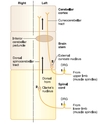SPINAL CORD Flashcards
SPINAL CORD
anatomy
(boundaries + gross anatomy)
starts: medulla below the pyramidal decussation
terminates: conus medullaris (L2)
fissures + sulcus

SPINAL CORD
anatomy
(gray and white matter)
GRAY MATTER
centrally located
butterfly
cell bodies + dendrites + proximal part of axon
WHITE MATTER
surrounds gray matter
tracts or fasciculli
axons

SPINAL CORD
components of gray matter
dorsal horn (sensory)
ventral horn (motor)
intermediate zone (autonomic)
T1 - L2 + S2 - S4
Clarke’s nucleus (T1 - L2)
SPINAL CORD
components of white matter
tracts and fasciculli
SPINAL CORD
spinal nerves
(31 roots)
8 cervical
12 thoracic
5 lumbar
5 sacral
1 coccygeal
SPINAL CORD
typical root
(spinal nerve)
ventral (motor) and dorsal (sensory) roots
dorsal root ganglion (sensory)
ventral and dorsal ramus (mixed)

SPINAL CORD
plexus
brachial: C5 - T1
(upper limbs)
lumbarsacral: L2 - S3
(lower limbs)
cervical + lumbar enlargement in spinal cord
SPINAL CORD
cauda equina
dorsal + ventral roots of
lumbar
sacral
coccygeal
SPINAL CORD
conus medullaris
caudal end of spinal cord
S3 - S5
adults: L2 vertebra
SPINAL CORD
filum terminale
slender pial extension
tethers the spinal cord to the bottom of the vertebral column
SPINAL CORD
types of nerve fibers
(Erlanger-Gasser)
Group A
heavily myelinated
Group B
moderataly myelinated
Group C
unmyelinated
SPINAL CORD
Group A nerve fiber
150 m/s
somatic fibers (sensory + motor)
subdivision
alpha
beta
gamma
delta
SPINAL CORD
Group B nerve fiber
15 m/s
sensory and motor autonomic fibers
sensory - general visceral afferent
motor - preganglionic
SPINAL CORD
Group C nerve fiber
no more than 2 m/s
sensory + motor fibers
sensory - pain + temp
motor - posganglionic (autonomic)
SPINAL CORD
other classification of fibers
(functional division)
motor fiber
(alfa, beta and gamma)
sensory fiber
(Ia, Ib, II, III and IV)
autonomic
(pre and postganglionic)

SPINAL CORD
motor fibers
alpha
A-alpha (Erlanger-Gasser)
extrafusal muscle fibers
beta
A-beta (Erlanger-Gasser)
gamma
A-gamma (Erlanger-Gasser)
intrafusal muscle fibers

SPINAL CORD
sensory fibers
Ia
A-alpha (Erlanger-Gasser)
muscle spindle (primary or annulospiral ending)
Ib
A-alpha (Erlanger-Gasser)
golgi tendon
II
A-beta (Erlinger-Gasser)
muscle spindle (flower-spray ending) + cutaneous mechanoreceptors
III
A-delta (Erlinger-Gasser)
free nerve ending (touch and pressure)
nociceptor (sharp pain)
cold receptors
IV
C (Erlinger-Gasser)
nociceptors (dull pain)
warmth receptors
SPINAL CORD
autonomic fibers
preganglionic fiber
B (Erlanger-Gasser)
posganglionic fiber
C (Erlanger-Gasser)
(pre is faster than post)
GRAY MATTER
rexed laminae
dorsal horn
I - VI
intermediate zone
VII
ventral horn
VIII - IX
GRAY MATTER
dorsal horn
(general statements)
sensory stimulation
(fibers enter the dorsolateral part of spina, via dorsal root)
+
neurons project to higher levels in CNS
+
part of neurons participate in reflexes
GRAY MATTER
dorsal horn
(rexed laminae)
medial division
proprioception (Ia and Ib, A-alpha fibers)
touch (II, A-beta fibers)
lateral division
sharp pain + cold (III, A-delta fibers)
dull pain, warmth (IV, C fiber)

GRAY MATTER
ventral horn
(general statements)
innervation of skeletal muscle
alpha + gamma motoneurons
dorsal fibers - flexors
ventral fibers - extensors
medial fibers - proximal musculature
lateral fibers - distal musculature

GRAY MATTER
ventral horn
(alpha and gamma motoneurons)
alpha motoneurons
A-alpha (Erlanger-Grasser)
extrafusal fibers
neuromuscular junction
gamma motoneurons
A-gamm (Erlanger-Grasser)
intrafusal fibers
muscle spindle (make more sensible to stretch)
GRAY MATTER
intermediate zone
T1 - L2
contains preganglionic sympathetic neuron cell bodies
+
Clarke nucleus (unconscious proprioception to the cerebellum)

























